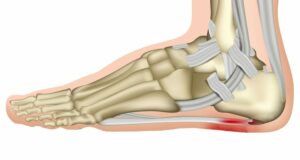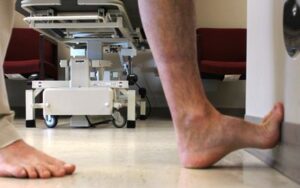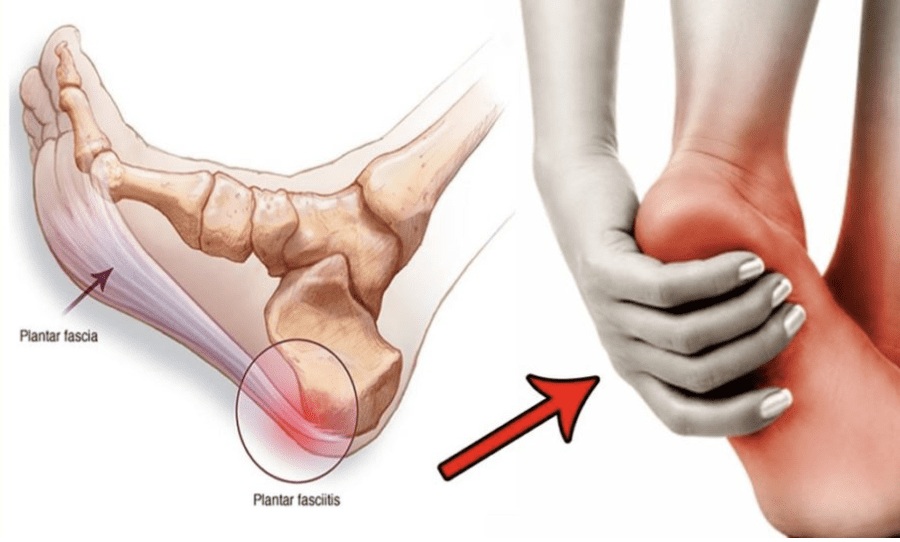Plantar Fasciitis is a condition that affects the heel of the foot. It can cause pain and discomfort, making it difficult to walk or stand. If you are suffering from Plantar Fasciitis, don’t worry – there are treatments available that can help relieve your symptoms. In this blog post, we will discuss the causes of Plantar Fasciitis treatment and the benefits that can provide you relief.
Contents
What Is Plantar Fasciitis?
 Plantar fasciitis is an inflammation of the plantar fascia, the connective tissue that runs along the bottom of your foot. It’s usually caused by overuse, such as from running or dancing. Plantar fasciitis can be painful. You may feel a sharp pain in your heel when you walk.
Plantar fasciitis is an inflammation of the plantar fascia, the connective tissue that runs along the bottom of your foot. It’s usually caused by overuse, such as from running or dancing. Plantar fasciitis can be painful. You may feel a sharp pain in your heel when you walk.
The pain is usually worse in the morning when you take your first steps out of bed. The pain may ease as you walk. But it may come back later in the day or after you’ve been standing for a long time. It is believed that plantar fasciitis is caused by repetitive microtrauma to the plantar fascia. This can occur with prolonged standing or walking, especially on hard surfaces. The exact cause of the condition is not always known.
But there are several risk factors that may increase your chance of developing plantar fasciitis, including:
- Being overweight
- Having a job that requires you to stand for long periods of time
- Walking or running on hard surfaces
- Wearing shoes that don’t fit well or provide enough support
- Having flat feet or high arches
If you have plantar fasciitis, you should find ways to relieve the pain. There are various kinds of help available, just make sure to find one-tailed to your needs.
When Should You Seek Plantar Fasciitis Treatment?
It is not uncommon for people to experience mild heel pain which goes away on its own. However, if you are experiencing heel pain that lasts longer than a couple of weeks or is severe, it is important to seek plantar fasciitis treatment. Some other symptoms that may indicate you need to seek treatment include:
- Heel pain that is worse in the morning or after periods of rest
- Heel pain that improves with activity
- Heel pain that is accompanied by swelling or redness
- Heel pain that causes you to limp or change your walking pattern
If you are experiencing any of these symptoms, it is important to consult with a medical professional to get an accurate diagnosis and determine the best treatment plan for you.
More often, it is recommended that people with plantar fasciitis try conservative treatments before resorting to more invasive options. So, if you are wondering how to treat plantar fasciitis, there are various types of treatment options.
What Are Some Plantar Fasciitis Treatment Options?
 This condition can be treated in a number of ways, but some plantar fasciitis treatment options are more effective than others. Here are some of the most popular methods:
This condition can be treated in a number of ways, but some plantar fasciitis treatment options are more effective than others. Here are some of the most popular methods:
Resting your feet
It is important to rest your feet when you have plantar fasciitis. This means avoiding activities that put a strain on your feet, such as running or walking long distances. You may need to take a break from these activities for several weeks or even months. For instance, you may need to use crutches when walking.
Wearing supportive shoes
One of the best things you can do for plantar fasciitis is to wear shoes that provide good support for your feet. This means that you should avoid high heels and other shoes that don’t offer much support. Instead, opt for shoes with a low heel and good arch support. If you’re not sure what kind of shoes to buy, ask a salesperson at a specialty running or athletic store for help.
Applying ice to your heels
It is important to reduce the inflammation as soon as possible when you are suffering from plantar fasciitis. Applying ice to your heels for 20 minutes several times a day can help to do this. You can wrap the ice in a towel or use a bag of frozen peas. Because the ice numbs the pain, it is important not to overdo it and to give your heel a break in between sessions.
Taking over-the-counter pain relievers
Sometimes, plantar fasciitis is caused by inflammation, and over-the-counter (OTC) pain relievers can help reduce this inflammation. Some examples of OTC pain relievers that you can take for plantar fasciitis include:
- ibuprofen (such as Advil or Motrin)
- naproxen (such as Aleve)
- acetaminophen (such as Tylenol)
If you take OTC pain relievers on a regular basis, be sure to follow the instructions on the package carefully. Taking too many of these medications can lead to serious side effects. So, follow the dosage instructions carefully and only take the recommended amount.
Stretching and strengthening exercises
 This might be the most important part of your treatment. Doing these exercises will help ease the pain and speed up your recovery. You should do these stretches several times a day, especially when you first wake up in the morning.
This might be the most important part of your treatment. Doing these exercises will help ease the pain and speed up your recovery. You should do these stretches several times a day, especially when you first wake up in the morning.
- Towel stretch
- Calf stretch
- Arch stretch
- Achilles stretch
- Plantar fascia release
Using shoe inserts or orthotics
It is common for people with plantar fasciitis to be prescribed shoe inserts or orthotics. These devices can help to redistribute your weight and take pressure off of the plantar fascia. For example, heel lifts or pads can be used to decrease the strain on the plantar fascia. With time, the inserts or orthotics will help to improve your symptoms.
Getting enough sleep
Sleep is an important part of recovery from plantar fasciitis. When you don’t get enough sleep, your body doesn’t have a chance to repair the damaged tissue. Aim for at least 7 hours of sleep per night. It is also important to avoid activities that put too much strain on your feet. You can get enough sleep with a few simple lifestyle changes:
- Go to bed and wake up at the same time every day.
- Create a relaxing bedtime routine.
- Avoid caffeine before bed.
- Invest in a comfortable mattress and pillow.
These are overall good sleep hygiene habits, but they’re especially important when you’re recovering from plantar fasciitis.
So, all in all, plantar fasciitis treatment is possible through a number of different methods. However, it’s important to not ignore the condition and to seek professional help as soon as possible. This way you can get back to your life pain-free!
What Are The Benefits?
 When you are looking for a treatment for plantar fasciitis, you will want to find something that has a lot of benefits. There are many different treatments that you can use, but not all of them will offer the same benefits. Here are some of the benefits that you should look for:
When you are looking for a treatment for plantar fasciitis, you will want to find something that has a lot of benefits. There are many different treatments that you can use, but not all of them will offer the same benefits. Here are some of the benefits that you should look for:
- Relief from pain – The most important benefit of any plantar fasciitis treatment is that it should provide you with relief from the pain. If a treatment does not provide you with this benefit, then it is not worth using.
- Improvement in flexibility – Another important benefit of a plantar fasciitis treatment is that it should help to improve your flexibility. It is important to have good flexibility in your feet so that you can avoid further injury.
- Strengthening of the muscles – The treatment should also help to strengthen the muscles in your feet. This will help to prevent further injury and will also make it easier for you to walk and run.
- Increase in blood circulation – A plantar fasciitis treatment can also help to increase the blood circulation in your feet. This is important because it will help to speed up the healing process.
- Reduction in inflammation – It also helps to reduce the amount of inflammation in your feet. This is important because it can help to reduce the pain that you are experiencing.
These are very common yet important benefits that you should look for when you are searching for a plantar fasciitis treatment. If you can find a treatment that offers all of these benefits, then you will be on the right track to getting the relief that you need. Also, you should make sure that the treatment is easy to use and does not require a lot of time or effort on your part.
Conclusion
To conclude, plantar fasciitis is a common condition that can be painful and debilitating. Although there is no one-size-fits-all treatment, there are a number of effective treatments available. If you are experiencing pain from plantar fasciitis, talk to your doctor or a physical therapist to find the best treatment option for you.
There are a number of different treatments available for plantar fasciitis. Each person will respond differently to different treatments, so it is important to work with your doctor or physical therapist to find the best option for you.
Physical Therapy help patients recover from pain. If you’re experiencing Back pain, Shoulder pain, Knee pain, Neck pain, Elbow pain, Hip pain, or Arthritis pain, a physical therapist at MantraCare can help: Book a physiotherapy session.


